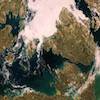Climatic Change
How closely might the fate of Sir John Franklin and his companions relate to climatic change in the Arctic? Could Franklin have anticipated that his ships would be stuck in the ice for two years or was it just bad luck that he could sail into Victoria Strait in the summer of 1846 but not be able to sail out again in the summer of 1847? What role did global climate change have to play in the imprisonment of the ships and in the subsequent searches for the lost expedition?
Arctic Climate and Sea Ice
The region`s climate is dynamic rather than static and has varied widely between different eras of recorded history and even one year to the next. In broad terms, the Arctic climate was shaped over millions of years by monumental forces, including the northward drift of land masses ringing the polar region and their attendant cooling. Continental cooling influenced surface winds to bring warm moist Atlantic air over the Arctic regions which, precipitating, caused the production of large glaciers and ice shelves that further cooled Arctic air masses, causing extensive surface pack ice in the region`s ocean channels during much of the year. Within this climatic structure, major climatic shifts have been documented over the millennia by scientists, especially through ice core analysis and other techniques.
Ice Conditions in the 1840s
Ice-core analysis involves drilling into glaciers and extracting cylindrical cores for dating analysis of its layers through various methods. In an article published in 1985 the botanist B.T. Alt and several co-authors assembled compelling evidence from ice-core and other data to explain the larger climatic contexts of Franklin`s last expedition. Showing that the Arctic climate was in a cooling phase in the late 1840s, Alt and her colleagues concluded that the Franklin Expedition sailed in a period of probable build-up of sea ice in the ocean channels of the Arctic archipelago and one of the worst periods in which to stage a naval expedition to this region in that century.
Ice Conditions in the Recent Past
Recent ice and climatology studies by scientist Tom Zagon suggest that even in current climatic conditions the Victoria Strait is often prone to ice congestion, clearing in some years but often remaining clogged with consolidated ice.
Ice Conditions in the New Future
Ironically, in the twentieth century, and especially in the last 30 years, scientists have documented a generally progressive warming of the Arctic climate alongside global changes. If these trends continue, it is projected that the Northwest Passage, formerly a largely unnavigable route, may become a commercially viable ocean pathway in the twenty-first century.





